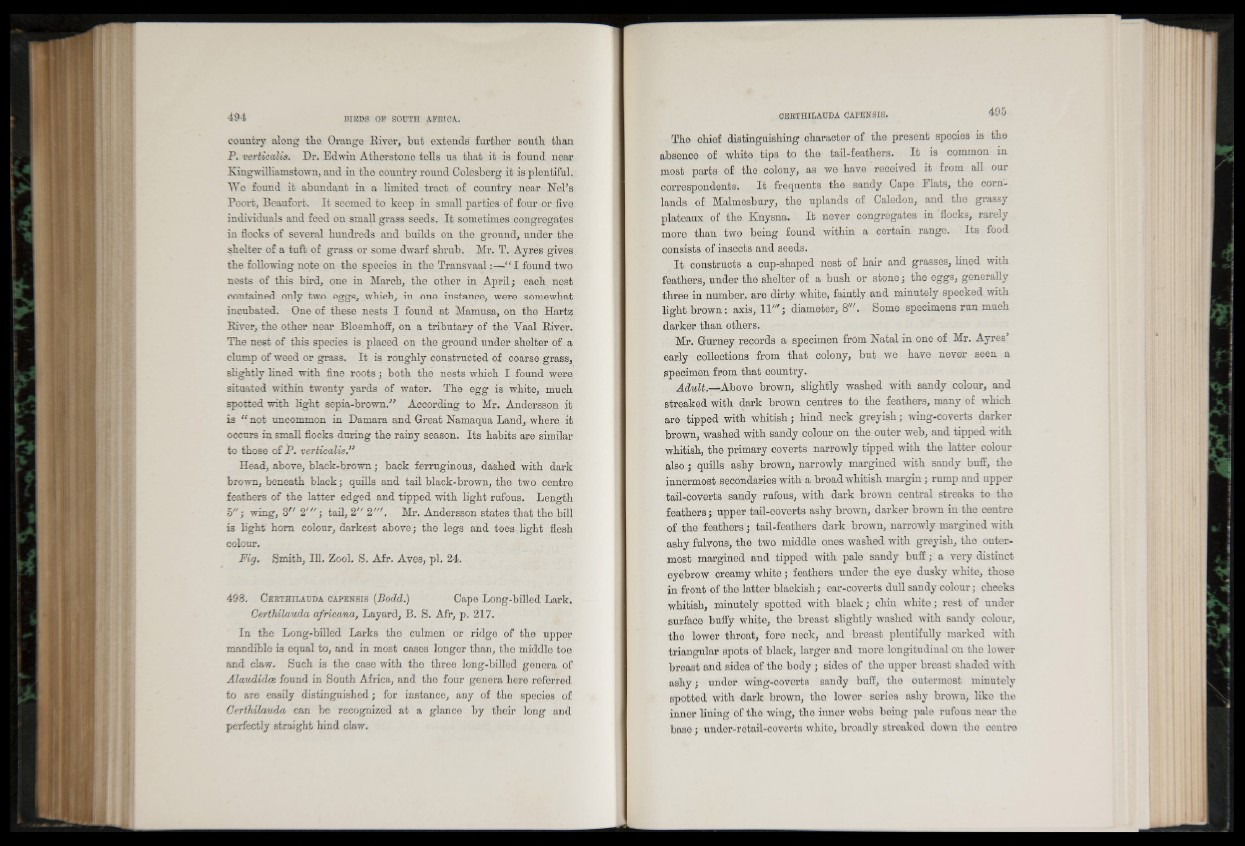
country along the Orange River, but extends farther south than
P. verticalis. Dr. Edwin Atherstone tells us that it is found near
Kingwilliamstown, and in the country round Colesberg it is plentiful.
We found it abundant in a limited tract of country near Nel’s
Poort, Beaufort. It seemed to keep in small parties of four or five
individuals and feed on small grass seeds. It sometimes congregates
in flocks of several hundreds and builds on the ground, under the
shelter of a tuft of grass or some dwarf shrub. Mr. T. Ayres gives
the following note on the species in the Transvaal:—“ I found two
nests of this bird, one in March, the other in April; each nest
contained only two eggs, which, in one instance, were somewhat
incubated. One of these nests I found at Mamusa, on the Hartz
River, the other near Bloemhoff, on a tributary of the Yaal River.
The nest of this species is placed on the ground under shelter of a
clump of weed or grass. It is roughly constructed of coarse grass,
slightly lined with fine roots; both the nests which I found were
situated within twenty yards of water. The egg is white, much
spotted with light sepia-brown.” According to Mr. Andersson it
is “ not uncommon in Damara and Great Namaqua Land, where it
occurs in small flocks during the rainy season. Its habits are similar
to those of P. verticalis.”
Head, above, black-brown; back ferruginous, dashed with dark
brown, beneath black; quills and tail black-brown, the two centre
feathers of the latter edged and tipped with light rufous. Length
5"; wing, 3" 2'//; tail, 2" 2"'. Mr. Andersson states that the bill
is light horn colour, darkest above; the legs and toes light flesh
colour.
Fig. Smith, 111. Zool. S. Afr. Aves, pi. 24.
498. C er thilau d a ca fens is (Bodd.) Cape Long-billed Lark.
Certhilauda africana, Layard, B. S. Afr, p. 217.
In the Long-billed Larks the culmen or ridge of the upper
mandible is equal to, and in most cases longer than, the middle toe
and claw. Such is the case with the three long-billed genera of
Alaudidce found in South Africa, and the four genera here referred
to are easily distinguished; for instance, any of the species of
Certhilauda can be recognized at a glance by their long and
perfectly straight hind claw.
The chief distinguishing character of the present species is the
absence of white tips to the tail-feathers. It is common in
most parts of the colony, as we have received it from all our
correspondents. It frequents the sandy Cape Flats, the corn-
lands of Malmesbury, the uplands of Caledon, and the grassy
plateaux of the Knysna. It never congregates in flocks, rarely
more th«n two being found within a certain range. Its food
consists of insects and seeds.
It constructs a cup-shaped nest of hair and grasses, lined with
feathers, under the shelter of a bush or stone; the eggs, generally
three in number, are dirty white, faintly and minutely specked with
light brown: axis, 11"'; diameter, 8'". Some specimens run much
darker than others.
Mr. Gurney records a specimen from Natal in one of Mr. Ayres’
early collections from that colony, but we have never seen a
specimen from that country.
Adult.—Above brown, slightly washed with sandy colour, and
streaked with dark brown centres to the feathers, many of which
are tipped with whitish; hind neck greyish; wing-coverts darker
brown, washed with sandy colour on the outer web, and tipped with
whitish, the primary coverts narrowly tipped with the latter colour
also; quills ashy brown, narrowly margined with sandy buff, the
innermost secondaries with a broad whitish margin; rump and upper
tail-coverts sandy rufous, with dark brown central streaks to the
feathers; upper tail-coverts ashy brown, darker brown in the centre
of the feathers; tail-feathers dark brown, narrowly margined with
ashy fulvous, the two middle ones washed with greyish, the outermost
margined and tipped with pale sandy buff; a very distinct
eyebrow creamy white; feathers under the eye dusky white, those
in front of the latter blackish; ear-coverts dull sandy colour; cheeks
whitish, minutely spotted with black; chin white; rest of under
surface buffy white, the breast slightly washed with sandy colour,
the lower throat, fore neck, and breast plentifully marked with
triangular spots of black, larger and more longitudinal on the lower
breast and sides of the body; sides of the upper breast shaded with
ashy; under wing-coverts sandy buff, the outermost minutely
spotted with dark brown, the lower series ashy brown, like the
inner lining of the wing, the inner webs being pale rufous near the
base; under-retail-coverts white, broadly streaked down the centre